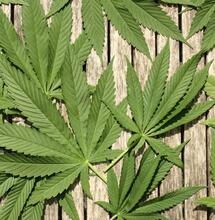Better Buds with Mr. Bill

Mr. Bill, our plant fix-it guy, invites you to ask him questions so that you can achieve better yields.
Mr. Bill, our plant fix-it guy, invites you to ask him questions so that you can achieve better yields.
Mr. Bill is ready to assist you by drawing upon over twenty-eight years of active grow shop experience - including answering growers' questions about the hydroponic industry. Before Mr. Bill opened his first store he worked in the agricultural industry for five years, growing tobacco.
|
Powdery mildew on Cannabis (credit: outdoors) |
Mr. Bill,
I have been growing for many years in a 4x4x8 room. The last two crops have been hit by powdery mildew. We have been experiencing higher humidity in southern California this year, allowing the mildew to affect the plants. How do you rid the plants of mildew? What steps should I take to clean up the grow room? Thank you, Mr. Bill!
Ocean Beach Mike
Hi Ocean Beach Mike,
I like my job - all I have to do is write a few hundred words and I am pretty much done, whereas you have a bit of work to do. You never mentioned the lights used... in this size of a room you probably have two lights, either 1000 or 600 watts, which will create a lot of humidity, compounding your dilemma. Plants will continue to take-up and gas-off water when lights are turned off - keep fans running off and on during dark cycle. Warm temperatures (65º - 78º F) and high humidity (40 to 100 percent) on stressed plants provide a perfect breeding ground for powdery mildew.
Powdery mildew propagates itself by spores; you will have spores both inside and outside of your building being drawn in by your exhaust fans. Remove any leaves where you can visibly see powdery mildew, trying not to disturb the mold. Have a container right beside you in which to place diseased leaves and remember, hygiene is key. Spores from many types of molds are constantly trying to establish themselves in their ideal growing environment; it is the plant's natural defenses, like ours, that will keep diseases in check. Keep your plants healthy and allow some room for air movement around them. Clean hands, work clothing and all exposed areas as thoroughly and as often as possible to prevent spreading the mildew, or cross-contaminating plants, areas or objects.
Remedy:
Place a filter over intake fans to stop any more spores from coming into the building. It will help to cool down your room if you have central air conditioning, but not enough in high-humidity areas - plus, HID lights produce 3.14 BTU of heat per watt. Dehumidifiers would also help; but again, the amount of air that will be flowing through the dehumidified room should be greater than what the dehumidifiers can remove. You will have to determine if dehumidifying your growing area is sufficient for the size of units you buy. The best way to accomplish this is to install a radiator water cooler, where all air in the room will recirculate through fins, lowering the humidity and heat before this air goes into your grow area. Allow space between plants, as this will help to keep plants drier.
Wash down all walls with a strong bleach or hydrogen peroxide (thirty-five percent) solution, at the rate of fifteen milliliters per liter of water. Mist plants with fifteen milliliters of thirty-five percent hydrogen peroxide per liter of water to help kill powdery mildew. Because the spores travel throughout your growing area, you will not get rid of them in one crop. Each crop after the installation of the water cooler will have less growth of powdery mildew; within a few crops the spores will have been greatly reduced, so that the health of active, growing plants can overcome any invasion. Finally, sterilize as much equipment as you can - after each crop - with the hydrogen peroxide solution.
|
Carefully burning sulfur in your grow space could solve your mildew problem. |
You may also want to consider trying a chemical application of sulfur. Sulfur can be applied by liquid spray bought in a bottle; another way is to use sulfur pellets that are heated up and gassed-off. Warning: be careful how you use sulfur burners, because high humidity combined with heavy doses of sulfur can cause sulfuric acid to form, damaging metal equipment.
The newest way of ridding grow rooms of fungus (mildew), viruses and bacteria on plants is a 'clean light hobby unit' that uses UV-C light. UV light has been known to kill mildew, viruses and bacteria for over 100 years. UV-C has been packaged so that all you have to do is wave the light over your crop and repeat every day till symptoms are not visible. It does not hurt to reapply every day; unlike many sprays, apply light to your plants from a distance of two to four inches, for two seconds per each area that the light covers.
An old remedy that you probably will not find in any store - which I am also under the impression that farmers cannot sell - is unpasteurized milk. Misting leaves with unpasteurized milk stops powdery mildew; maybe it has something to do with all the great vitamins and mineral elements in unpasteurized milk - you might want to try organic milk. David Bruer, a professor and winemaker once interviewed on the subject by ScienceNews Online, revealed that re-hydrated powdered milk or even skim milk will be just as effective; raw milk is apparently not the only method.
Spray plants weekly or twice per month with a solution of ten- to twenty percent 'raw' milk in water (ratio of 1:9). Some studies suggest that concentrations above thirty percent can lead to other types of mold, so watch your dilutions carefully. Milk spraying is most effective in bright, direct sunlight, or when your lamps are on. You may also find that milk sprays work better as a preventative in certain regions.
Misting plants with a solution of baking soda will change the pH of leaves, providing uncomfortable growing conditions for powdery mildew.
DO NOT MIST PLANTS WITH MORE THAN ONE OF THE ABOVE-MENTIONED REMEDIES AT A TIME, OR WITHIN TWENTY-FOUR HOURS!
Finally, if you were to grow some cucumbers in your grow room, this would provide you with early signs that conditions are becoming worryingly optimal for powdery mildew, as cucumbers are highly susceptible to it.
Cheers,
Bill



